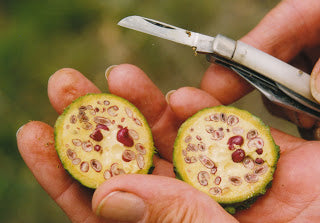Australias fragrant Native Orange
Stunning flowers and gorgeous fruit too. It has many seeds like a passionfruit and ripens in summer. It is very high in vitamin C.


◎ Common Name: Native Orange, Wild Orange, Native Pomegranate, Bumble Tree
◎ Scientific or Latin Name: Capparis mitchellii
◎ Comparison: Passionfruit
◎ Seasonality: Rare
◎ Region: Arid
◎ Taste Profile: It is quite tasty, although a bit astringent. Some describe the flavour as like passion fruit with a kerosene after-taste. The seeds are peppery and should be removed from the flesh and the skin is bitter and inedible.
◎ Types: The Wild Orange is not related to oranges, but to capers. There are about 250 species in the genus with approximately 16 native to Australia.
Benefits
- Wild Orange is highly valued as a bush-tucker food.
- It contains high levels of nutritional value, especially Vitamin C, thiamine, antioxidants, and some minerals.
- It has been identified by CSIRO as having significant economic potential – unique flavour and fragrance sought after by perfumery, skincare and confectionary industries.
- Wild Orange is antimicrobial.
Traditional Aboriginal Food and Uses
The fruits of many of the species were important to Aborigines as a food. Aboriginal people ate the raw fruit which is a good source of vitamin C and thiamine.
Medicinally it was valued by indigenous communities in central Australia, and also features culturally as part of indigenous Dreaming heritage.
Western & Modern
Native Wild Orange has a high level of Vitamin C and is considered as valuable in the confectionery, flavouring and preservative industries. The fruit can be eaten raw or can be stewed and can be used in desserts, cordials or savoury dishes like curries, casseroles, rice and couscous.
The best time for fruit tends to be mid to late summer and it is suggested that timing is critical for harvesting and consumption to get the flavour just right. It makes a delicious drink. The juice and pulp are consumed but not seeds or rind which are considered peppery or astringent.
Medicinal
Due to the high levels of Vitamin C in Native Wild Orange, it is starting to feature more heavily in skincare products. Vitamin C is a natural antioxidant which hydrates the skin and fights the signs of visible ageing. The antioxidant and anti-inflammatory properties can aid in wound healing and blemish correction.
◎
Note: The term 'Bush Tucker' and 'Bush Food' are not Warndu's preferred terms for Australian Native Ingredients or Australian Botanicals.
Images: Photo by Patricia Gardener, featured by Toowoomba Plants.
